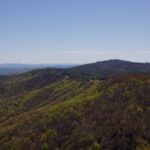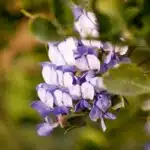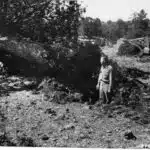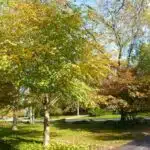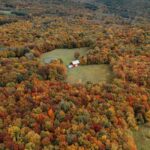The Rocky Mountain juniper tree is a species of conifer native to the western United States. Known for its rugged beauty and hardy nature, this tree has been a staple in landscaping and forestry for centuries. As an arborist or horticulturalist, understanding how to properly grow and care for Rocky Mountain junipers is essential in ensuring its longevity and health.
This article aims to provide comprehensive guidance on how to cultivate and maintain healthy Rocky Mountain juniper trees. From selecting the right soil type to pruning techniques, readers will learn practical tips on how to ensure their trees thrive. Whether you are a seasoned professional or simply an enthusiast looking to add this iconic tree species to your garden, this guide will help you achieve your goals with confidence.
Understanding The Characteristics Of Rocky Mountain Juniper Trees
Juniper trees are classified under the genus Juniperus, which consists of over 50 species. One of the most common juniper trees in North America is the Rocky Mountain juniper tree (Juniperus scopulorum). Identifying this tree involves looking out for its unique features such as the blue-green needles that grow in clusters of three, and a conical crown shape with reddish-brown bark.
Rocky Mountain junipers are well-adapted to thrive in areas with high altitudes and cold temperatures. These trees can grow up to 50 feet tall and have a moderate growth rate. They typically prefer full sun exposure but can tolerate some shade. In addition, they have developed several adaptations to survive in adverse weather conditions such as drought tolerance, resistance to wildfires, and protection against extreme cold.
Understanding the characteristics of Rocky Mountain juniper trees is crucial for their successful care and maintenance. As arborists or horticulturalists, it is essential to note that these trees require specific growing conditions to reach their optimal growth potential. The subsequent section will delve into selecting the right soil type for rocky mountain junipers’ optimal growth.
Selecting The Right Soil Type For Optimal Growth
In understanding the characteristics of Rocky Mountain Juniper Trees, it is important to note that they thrive in a variety of soils but do best in well-drained soils. These trees have adapted well to rocky and sandy soils common in mountainous areas, but they can also grow in clay loam soils. When growing these trees, it is important to choose the appropriate pH level for optimal growth. A pH range of 6.0-7.5 is ideal for Rocky Mountain Juniper Trees.
When selecting soil for your Juniper Tree, it is essential to consider its nutrient requirements. These trees are low-maintenance and do not require excessive nutrients. They prefer a balanced fertilizer with an NPK ratio of 10-10-10 or 8-8-8 during the growing season. Fertilizers containing high amounts of nitrogen should be avoided as they can promote excessive foliage growth.
In summary, choosing the appropriate soil type for your Rocky Mountain Juniper Tree involves considering factors such as drainage and pH levels while ensuring that nutrient requirements are met. The next step involves selecting the best location for your tree to grow and thrive in optimal conditions.
Choosing The Best Location For Your Juniper Tree
When selecting a location to plant your rocky mountain juniper tree, it’s essential to consider the amount of sunlight the tree will receive. These trees thrive in full sun exposure, so choose a location that gets at least six hours of direct sunlight per day. If possible, avoid planting in areas with shade or partial shade. This will ensure that your juniper tree receives adequate sunlight for optimal growth.
Another critical factor to consider when deciding where to plant your juniper tree is soil drainage. Junipers require well-draining soil to prevent root rot and other moisture-related issues. Avoid planting in areas with poor drainage, such as low lying areas or compacted soils. Instead, choose an area with well-draining soil or amend the soil by adding organic matter such as compost or peat moss.
Weather conditions should also be taken into account when choosing a location for your juniper tree. Rocky mountain junipers are hardy trees that can tolerate a range of temperatures but prefer cooler climates. They grow best in USDA Hardiness Zones 4-7, which includes much of the central and western United States. Additionally, avoid planting in areas with strong winds or heavy snowfall, which can damage the tree’s branches and foliage.
As you select the perfect location for your rocky mountain juniper tree, remember to consider factors like sunlight exposure, soil drainage, and weather conditions. By taking these factors into account, you can ensure that your tree will thrive and provide beauty and enjoyment for years to come. In the next section, we’ll discuss watering techniques and strategies to keep your juniper tree healthy and vibrant.
Watering Techniques And Strategies
After choosing the perfect location for your Rocky Mountain Juniper tree, it is important to establish a proper watering regimen. While these trees are drought-tolerant, they still require consistent moisture to thrive. Deep watering is recommended, as it promotes root growth and overall tree health. This involves applying water slowly and deeply to the soil around the base of the tree.
One effective method for deep watering is drip irrigation. This system delivers water directly to the roots, reducing evaporation and runoff. It also allows for precise control over the amount of water being applied. When using drip irrigation, it is important to monitor soil moisture levels regularly and adjust watering times accordingly.
To ensure your Rocky Mountain Juniper remains healthy and vibrant, consider implementing a mulching program. Mulch helps retain soil moisture by reducing evaporation and suppressing weed growth. It also encourages beneficial microorganisms in the soil that contribute to plant health. Apply a 2-3 inch layer of mulch around the base of the tree, avoiding direct contact with the trunk.
Transition: By providing your juniper tree with adequate water through deep watering techniques such as drip irrigation, you can ensure its optimal health. However, nurturing your tree goes beyond just watering it properly – fertilizing is equally crucial for its overall wellbeing.
Fertilizing Your Juniper Tree For Optimal Health
For a flourishing and fruitful rocky mountain juniper tree, it is essential to provide adequate nutrients. The use of fertilizers is a great way to boost the health of your tree. When selecting a fertilizer, there are two main options: organic and synthetic. Organic fertilizers are made from natural sources such as animal manure or compost. Synthetic fertilizers, on the other hand, are chemically produced. While both options have benefits, organic fertilizers are preferred as they release nutrients slowly over time and improve soil structure.
Timing of fertilization is crucial for optimal growth of your juniper tree. Fertilization should be done in early spring before new growth begins. This ensures that the tree has sufficient nutrients to support its growth throughout the growing season. It is important not to over-fertilize your tree as this can lead to excessive growth and weak branches.
In summary, choosing the right fertilizer and timing of application can greatly impact the health and vitality of your rocky mountain juniper tree. By opting for organic fertilizers and applying them at the appropriate time, you can ensure that your tree receives all the necessary nutrients for optimal growth and development.
Transitioning into Pruning Techniques for Shape and Structure:
Maintaining proper pruning techniques is equally important in ensuring healthy growth of your juniper tree. By shaping and structuring your tree correctly, you can promote healthy growth patterns while preventing any potential damage or disease.
Pruning Techniques For Shape And Structure
Fertilizing your juniper tree is a crucial step in maintaining its optimal health. However, it’s important to note that fertilization alone won’t guarantee the tree’s good health. Regular pruning is also necessary to ensure its longevity and aesthetic appeal. Pruning frequency varies depending on the species of juniper and the desired shape and structure.
Shaping tips for rocky mountain juniper trees involve identifying the tree’s growth habit and natural shape early on. This will help you determine which branches to prune during each pruning session. In general, it’s recommended to prune no more than one-third of the tree’s foliage at a time to avoid damage or shock. If possible, prune during the tree’s dormant season in late winter or early spring.
Regular pruning not only helps maintain your juniper tree’s shape and structure but also prevents common issues like thinning foliage, dead branches, and overcrowding. It also promotes air circulation, which reduces moisture buildup and helps prevent fungal diseases from forming. In addition to shaping tips for rocky mountain juniper trees, proper pruning techniques can also encourage healthy new growth and increase fruit production in some species.
To prevent common pests and diseases from damaging your juniper tree, it’s important to identify them early on and take appropriate action. Common pests include spider mites, scale insects, and bagworms, while common diseases include cedar-apple rust and root rot. Preventative measures like proper watering techniques can go a long way in preventing these issues from occurring in the first place. However, if you do notice signs of infestation or disease, consult with a professional arborist or horticulturalist for treatment options tailored specifically to your rocky mountain juniper tree.
Preventing And Treating Common Pests And Diseases
Preventing pests is a crucial aspect of maintaining healthy Rocky Mountain juniper trees. These trees are susceptible to infestations from various pests, including spider mites, bagworms, and scale insects. Regularly inspecting the tree for any signs of an infestation is important. Early detection can help prevent the spread of the infestation and make it easier to control.
One way to prevent pests from attacking your juniper trees is by keeping them healthy. Proper watering, fertilization, and pruning can go a long way in preventing infestations. Overwatering or underwatering can cause stress to the tree, making it more vulnerable to pests and diseases. Fertilizing regularly with appropriate nutrients can also strengthen the tree’s defenses against pests. Pruning diseased or damaged branches can help prevent insect infestations as well.
Treating disease in Rocky Mountain juniper trees should be done as soon as possible after discovering its symptoms. Common diseases that affect these trees include cedar-apple rust, root rot, and twig blight. Cedar-apple rust is a fungal disease characterized by orange spots on the leaves and stems during springtime. Root rot occurs when there is too much moisture around the roots causing them to decay. Twig blight causes discoloration and eventual death of young twigs on the tree.
In conclusion, preventing pests and treating diseases in Rocky Mountain juniper trees requires regular inspection and maintenance practices like proper watering, fertilization, and pruning. Early detection of an infestation or disease can make it easier to control before it spreads throughout the entire tree. In the next section, we will discuss how to transplant Rocky Mountain juniper trees effectively while minimizing harm to their root systems.
Transplanting Rocky Mountain Juniper Trees
Ah, the joys of moving! Nothing quite compares to packing up everything you own and starting anew in a different location. Well, except for maybe transplanting trees. Transplanting Rocky Mountain Juniper Trees can be a daunting task, but with the right Transplanting techniques and root care, it can be done successfully.
First things first: timing is key when it comes to transplanting juniper trees. The best time to transplant is during the fall or early spring before new growth has begun. Once you’ve chosen your location, dig a hole twice as wide as the root ball and deep enough so that the top of the root ball sits slightly above ground level.
When it comes to root care, it’s important not to damage or disturb them too much during the transplanting process. Gently loosen any tangled roots on the surface of the root ball and prune any damaged or broken roots. Add some compost or well-draining soil to the bottom of your hole before placing your tree in its new home. Fill in around the roots with more soil and water thoroughly.
Transplanting Rocky Mountain Juniper Trees can be a rewarding experience if done correctly. With proper Transplanting techniques and root care, your tree should thrive in its new location for years to come. But what about propagating juniper trees? Let’s explore some methods for doing just that.
Propagation Methods For Juniper Trees
Cutting propagation is a common method used to propagate juniper trees, typically involving a cutting of a branch with several sets of leaves. Seed propagation is a slower method, but can be done by sowing seeds in a potting mix and allowing them to germinate. Grafting propagation is a more advanced method of juniper tree propagation, involving the joining of two different plants to create a new plant. The juniper tree can be propagated through several different techniques, such as layering, air-layering, and whip-grafting, each of which requires careful attention to detail. Careful attention to the environment and the cutting or grafting technique will greatly increase the success rate of propagating juniper trees. It is important to follow the instructions for each propagation method to ensure the best results in terms of survival and growth.
Cutting Propagation
Cutting propagation is a commonly used method for propagating juniper trees. To propagate using this method, it’s essential to select healthy and disease-free branches from the parent plant. It’s recommended to take cuttings during early spring or late summer when the plant growth is at its peak.
To increase the chances of successful rooting, it’s advisable to treat the cuttings with rooting hormone before planting them in well-draining soil. The rooting hormone can help stimulate root growth and improve the success rate of stem cutting techniques. Once treated with hormone, the cuttings should be planted in a pot filled with well-draining soil and kept moist.
After planting, place the pot in a location that receives bright but indirect sunlight and maintain consistent moisture levels until roots have formed. Over time, new growth will emerge from the top of the cutting, indicating that roots have formed and established themselves in the soil. Cutting propagation requires patience and attention to detail but can be an effective way to grow new juniper trees from existing ones without much effort or expense involved.
Seed Propagation
In addition to cutting propagation, reproducing juniper trees can also be done through seed propagation. This method involves planting juniper seeds in a suitable growing medium and providing the necessary conditions for germination and growth. The germination process of juniper seeds can take several weeks or even months, so patience is necessary when using this propagation technique.
To begin the seed propagation process, start by collecting mature juniper cones that have already opened up to release their seeds. The seeds should then be separated from the cone debris before being planted in a well-draining potting mix. It’s essential to ensure that the soil remains moist throughout the germination process to promote successful seedling development.
Juniper seeds require specific growth requirements such as consistent moisture levels, warm temperatures, and adequate lighting. It’s best to keep the newly planted seeds in a location with bright but indirect sunlight and maintain consistent moisture levels until they have established themselves. Once the seedlings have developed into young plants, they can be transplanted into larger pots or directly into outdoor soil where they can continue their growth journey towards becoming mature juniper trees.
Grafting Propagation
Grafting propagation is another method that can be used to reproduce juniper trees. This technique involves joining a scion, which is the desired plant variety, with a rootstock of another plant. Grafting techniques can be used to create new varieties of juniper trees or to propagate specific qualities such as disease resistance. Grafting propagation requires skill and care but can produce successful results when done correctly.
When using grafting techniques for juniper tree propagation, it’s essential to choose healthy plants and use sharp tools to minimize damage during the process. The scion and rootstock should be compatible in terms of size, growth habit, and environmental requirements for optimal success rates. Some popular grafting methods include whip-and-tongue grafts or side-veneer grafts, which involve cutting both the scion and rootstock at an angle before attaching them together.
Propagation tips for successful grafting include keeping the newly grafted plant in a protected environment with consistent moisture levels and adequate lighting until it has established itself. It’s also important to monitor the grafted area for signs of infection or rejection and make any necessary adjustments promptly. With patience and attention to detail, grafting propagation can yield beautiful and healthy juniper trees that will thrive in any landscape setting.
Winter Care And Protection Strategies
During the winter season, Rocky Mountain Juniper trees require extra care and protection to prevent them from getting damaged due to cold temperatures. As a tree owner, you need to be aware of some essential winter care strategies that will help keep your juniper trees healthy throughout this season. The following are some winter care and protection techniques that are recommended for rocky mountain juniper trees.
Mulching: Mulch acts as an insulation layer for the soil around the tree roots, preventing them from freezing in the winter months. Apply a 3-4 inch thick layer of mulch around the base of the tree, but ensure it does not touch the trunk.
Winter Watering: During dry winters, evergreens like junipers can suffer desiccation or drying out since they lose water through their leaves even when dormant. Therefore, it is essential to give your juniper trees enough water during this period to avoid dehydration.
Frost Protection Techniques: When temperatures drop below freezing levels, frost can damage your juniper trees’ foliage and small twigs. To protect your trees from frost damage, you can use burlap or other breathable fabrics to cover them up during these cold periods.
To ensure that your Rocky Mountain Juniper trees remain healthy year-round, proper maintenance is crucial. By implementing these winter care strategies such as mulching, winter watering, and frost protection techniques you will keep your trees thriving through this cold season without issues! In our next section, we will discuss some summer care and maintenance tips for Rocky Mountain Juniper Trees that will help promote their growth and health during warmer months.
Summer Care And Maintenance Tips
How can you ensure that your Rocky Mountain Juniper trees stay healthy and thriving during the summer months? One important aspect of summer care for these trees is regular watering. Ensure that you water the tree deeply once a week, providing enough moisture to reach the roots. This will help the tree withstand hot temperatures and dry conditions.
Another critical aspect of summer care for Rocky Mountain Juniper trees is pest prevention. Regularly inspect your tree for any signs of pests, such as spider mites or bagworms. These pests can cause significant damage to the tree if left unchecked. If you spot an infestation, take immediate action to remove the affected branches and treat the area with an appropriate insecticide.
Mulching benefits are another essential component of summer care for Rocky Mountain Juniper trees. Applying a layer of mulch around the base of the tree can help retain moisture in the soil, regulate soil temperature, and prevent weed growth. Additionally, organic mulches such as wood chips or bark can slowly release nutrients into the soil over time, providing essential nourishment to your tree’s root system.
As mentioned earlier, mulching is crucial when it comes to caring for Rocky Mountain Juniper trees during summer. In addition to retaining moisture and preventing weeds from growing around your tree’s base, mulch promotes healthy soil by introducing organic matter into it. The next section will discuss various mulching and weed control techniques that will help keep your Rocky Mountain Juniper trees looking their best all season long.
Mulching And Weed Control Techniques
After ensuring proper care and maintenance during the summer season, it is important to focus on mulching and weed control techniques for rocky mountain juniper trees. Organic mulching provides several benefits such as conserving soil moisture and suppressing weed growth. It also helps in regulating soil temperature, reducing erosion, and enhancing soil fertility by adding organic matter. Organic mulches can be made of bark chips, leaves, grass clippings or compost. These materials should be applied at a depth of 2-3 inches around the base of the tree.
Chemical weed control is another option that can be used to manage weeds around rocky mountain juniper trees. However, it is essential to use herbicides carefully as they can harm the tree if not applied properly. Selective herbicides are recommended as they target specific weeds without harming other plants or the environment. Pre-emergent herbicides are effective against annual weeds while post-emergent herbicides work best on perennial weeds.
In conclusion, mulching and weed control techniques play a crucial role in maintaining healthy rocky mountain juniper trees. Organic mulching provides numerous benefits such as water retention, preventing erosion and adding nutrients to the soil. Chemical weed control can also be used but must be done with caution to avoid damaging the tree or surrounding plants. With proper care and maintenance techniques, rocky mountain juniper trees can thrive in any landscape design ideas featuring them.
Landscape Design Ideas Featuring Rocky Mountain Junipers
The Rocky Mountain Juniper is a stunning tree that can add a unique touch to any landscape design. With its striking blue-green foliage and rugged bark, it can create an eye-catching focal point in any garden or yard. These trees are particularly well-suited for xeriscaping and other low-maintenance landscaping styles, as they are drought-tolerant and require minimal care once established.
For those seeking landscaping inspiration, the Rocky Mountain Juniper offers a wide range of creative arrangements. They can be used as accent trees, planted in groupings to form a natural windbreak or privacy screen, or even incorporated into mixed border plantings with other conifers and evergreens. Their compact size also makes them ideal for smaller landscapes or container gardening.
Incorporating Rocky Mountain Junipers into your landscape design offers endless possibilities for creating beautiful and unique outdoor spaces. Whether you choose to use them as a stand-alone specimen tree or incorporate them into larger planting schemes, their hardy nature and versatile growth habits make them an excellent choice for any garden or yard. Next, we will explore some tips for troubleshooting common problems and issues that may arise when growing these trees.
Troubleshooting Common Problems And Issues
Identifying symptoms of common problems and issues in rocky mountain juniper trees is essential for maintaining their health and vigor. One of the most common problems is spider mite infestation, which can cause yellowing and browning of needles, as well as webbing on the tips of branches. Another issue is root rot, caused by overwatering or poor drainage, which can lead to wilting and discoloration of foliage. Additionally, scale insects may feed on the sap of the tree, causing yellow spots on the foliage.
Prevention measures for these problems include regular inspection of trees for signs of infestation or disease. It is also advisable to maintain proper watering practices by allowing soil to dry out between waterings and ensuring good drainage. Pruning off any affected branches or foliage can help prevent further spread of pests or disease. Additionally, applying horticultural oil or insecticidal soap may help control spider mites and scale insects.
Taking proactive steps to address common problems and issues in rocky mountain juniper trees is crucial in maintaining their health and beauty. Early identification of symptoms allows for timely intervention, preventing further damage to the tree. By following preventative measures such as monitoring watering practices and implementing appropriate pest management techniques, arborists can ensure that these trees thrive in their natural habitats.
Resources For Further Learning And Support
After understanding the common problems and issues that may arise in growing and caring for rocky mountain juniper trees, it is important to seek further resources for learning and support. Did you know that there are over 100 online communities dedicated to gardening and horticulture? These communities can provide valuable insights into the best practices for growing and caring for rocky mountain junipers. Joining an online community can also provide a platform for asking questions, sharing experiences, and connecting with other enthusiasts.
Expert consultations are another excellent resource for those looking to deepen their knowledge of rocky mountain junipers. Consulting with a local arborist or horticulturist can provide tailored advice specific to your region’s climate, soil conditions, and other unique factors. This personalized guidance can help you overcome any challenges you may face while cultivating these beautiful trees.
In addition to online communities and expert consultations, there are numerous books, articles, and academic publications available on the subject of growing and caring for rocky mountain juniper trees. By pursuing ongoing education in this area, you can ensure that your trees receive the care they need to thrive for years to come. Remember: healthy trees not only beautify our environment but also contribute significantly to our overall well-being.
Conclusion
Rocky Mountain Juniper trees are a beautiful addition to any landscape. Understanding the characteristics of this tree is important to ensure optimal growth and health. The right soil type, location, watering techniques, fertilizing and mulching strategies are all essential elements in caring for this tree.
Just like tending to a garden, caring for Rocky Mountain Junipers requires patience and dedication. It is imperative that we give these trees the care they need so they can thrive and bring beauty to our surroundings. Like the intricate roots of the tree that weave through the soil, our efforts in maintaining its health must be just as meticulous. As arborists and horticulturalists, it is our duty to ensure that these natural wonders continue to flourish and inspire awe for generations to come.
Image Credits
- “Juniper Tree in Juniper Dunes Wilderness” by BLM Oregon & Washington (featured)




